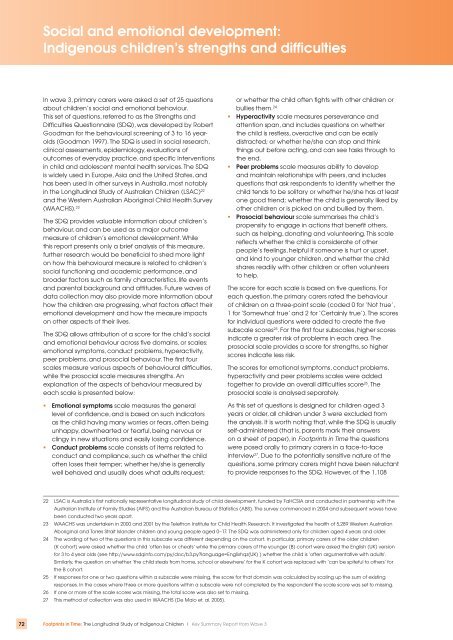Summary Report - pdf - Department of Families, Housing ...
Summary Report - pdf - Department of Families, Housing ...
Summary Report - pdf - Department of Families, Housing ...
Create successful ePaper yourself
Turn your PDF publications into a flip-book with our unique Google optimized e-Paper software.
Social and emotional development:Indigenous children’s strengths and difficultiesIn wave 3, primary carers were asked a set <strong>of</strong> 25 questionsabout children’s social and emotional behaviour.This set <strong>of</strong> questions, referred to as the Strengths andDifficulties Questionnaire (SDQ), was developed by RobertGoodman for the behavioural screening <strong>of</strong> 3 to 16 yearolds(Goodman 1997). The SDQ is used in social research,clinical assessments, epidemiology, evaluations <strong>of</strong>outcomes <strong>of</strong> everyday practice, and specific interventionsin child and adolescent mental health services. The SDQis widely used in Europe, Asia and the United States, andhas been used in other surveys in Australia, most notablyin the Longitudinal Study <strong>of</strong> Australian Children (LSAC) 22and the Western Australian Aboriginal Child Health Survey(WAACHS). 23The SDQ provides valuable information about children’sbehaviour, and can be used as a major outcomemeasure <strong>of</strong> children’s emotional development. Whilethis report presents only a brief analysis <strong>of</strong> this measure,further research would be beneficial to shed more lighton how this behavioural measure is related to children’ssocial functioning and academic performance, andbroader factors such as family characteristics, life eventsand parental background and attitudes. Future waves <strong>of</strong>data collection may also provide more information abouthow the children are progressing, what factors affect theiremotional development and how the measure impactson other aspects <strong>of</strong> their lives.The SDQ allows attribution <strong>of</strong> a score for the child’s socialand emotional behaviour across five domains, or scales:emotional symptoms, conduct problems, hyperactivity,peer problems, and prosocial behaviour. The first fourscales measure various aspects <strong>of</strong> behavioural difficulties,while the prosocial scale measures strengths. Anexplanation <strong>of</strong> the aspects <strong>of</strong> behaviour measured byeach scale is presented below:• Emotional symptoms scale measures the generallevel <strong>of</strong> confidence, and is based on such indicatorsas the child having many worries or fears, <strong>of</strong>ten beingunhappy, downhearted or tearful, being nervous orclingy in new situations and easily losing confidence.• Conduct problems scale consists <strong>of</strong> items related toconduct and compliance, such as whether the child<strong>of</strong>ten loses their temper; whether he/she is generallywell behaved and usually does what adults request;or whether the child <strong>of</strong>ten fights with other children orbullies them. 24• Hyperactivity scale measures perseverance andattention span, and includes questions on whetherthe child is restless, overactive and can be easilydistracted; or whether he/she can stop and thinkthings out before acting, and can see tasks through tothe end.• Peer problems scale measures ability to developand maintain relationships with peers, and includesquestions that ask respondents to identify whether thechild tends to be solitary or whether he/she has at leastone good friend; whether the child is generally liked byother children or is picked on and bullied by them.• Prosocial behaviour scale summarises the child’spropensity to engage in actions that benefit others,such as helping, donating and volunteering. This scalereflects whether the child is considerate <strong>of</strong> otherpeople’s feelings, helpful if someone is hurt or upset,and kind to younger children, and whether the childshares readily with other children or <strong>of</strong>ten volunteersto help.The score for each scale is based on five questions. Foreach question, the primary carers rated the behaviour<strong>of</strong> children on a three-point scale (coded 0 for ‘Not true’,1 for ‘Somewhat true’ and 2 for ‘Certainly true’). The scoresfor individual questions were added to create the fivesubscale scores 25 . For the first four subscales, higher scoresindicate a greater risk <strong>of</strong> problems in each area. Theprosocial scale provides a score for strengths, so higherscores indicate less risk.The scores for emotional symptoms, conduct problems,hyperactivity and peer problems scales were addedtogether to provide an overall difficulties score 26 . Theprosocial scale is analysed separately.As this set <strong>of</strong> questions is designed for children aged 3years or older, all children under 3 were excluded fromthe analysis. It is worth noting that, while the SDQ is usuallyself-administered (that is, parents mark their answerson a sheet <strong>of</strong> paper), in Footprints in Time the questionswere posed orally to primary carers in a face-to-faceinterview 27 . Due to the potentially sensitive nature <strong>of</strong> thequestions, some primary carers might have been reluctantto provide responses to the SDQ. However, <strong>of</strong> the 1,10822 LSAC is Australia’s first nationally representative longitudinal study <strong>of</strong> child development, funded by FaHCSIA and conducted in partnership with theAustralian Institute <strong>of</strong> Family Studies (AIFS) and the Australian Bureau <strong>of</strong> Statistics (ABS). The survey commenced in 2004 and subsequent waves havebeen conducted two years apart.23 WAACHS was undertaken in 2000 and 2001 by the Telethon Institute for Child Health Research. It investigated the health <strong>of</strong> 5,289 Western AustralianAboriginal and Torres Strait Islander children and young people aged 0–17. The SDQ was administered only for children aged 4 years and older.24 The wording <strong>of</strong> two <strong>of</strong> the questions in this subscale was different depending on the cohort. In particular, primary carers <strong>of</strong> the older children(K cohort) were asked whether the child ’<strong>of</strong>ten lies or cheats’ while the primary carers <strong>of</strong> the younger (B) cohort were asked the English (UK) versionfor 3 to 4 year olds (see http://www.sdqinfo.com/py/doc/b3.py?language=Englishqz(UK) ) whether the child is ’<strong>of</strong>ten argumentative with adults’.Similarly, the question on whether ’the child steals from home, school or elsewhere’ for the K cohort was replaced with ‘can be spiteful to others’ forthe B cohort.25 If responses for one or two questions within a subscale were missing, the score for that domain was calculated by scaling up the sum <strong>of</strong> existingresponses. In the cases where three or more questions within a subscale were not completed by the respondent the scale score was set to missing.26 If one or more <strong>of</strong> the scale scores was missing, the total score was also set to missing.27 This method <strong>of</strong> collection was also used in WAACHS (De Maio et. al. 2005).72 Footprints in Time: The Longitudinal Study <strong>of</strong> Indigenous Children | Key <strong>Summary</strong> <strong>Report</strong> from Wave 3




![pdf [107kB] - Department of Families, Housing, Community Services](https://img.yumpu.com/51272499/1/190x245/pdf-107kb-department-of-families-housing-community-services.jpg?quality=85)










![Land Claim - pdf [278kB] - Department of Families, Housing ...](https://img.yumpu.com/47002639/1/184x260/land-claim-pdf-278kb-department-of-families-housing-.jpg?quality=85)

![Borroloola Land Claim - pdf [299kB] - Department of Families ...](https://img.yumpu.com/46103973/1/184x260/borroloola-land-claim-pdf-299kb-department-of-families-.jpg?quality=85)